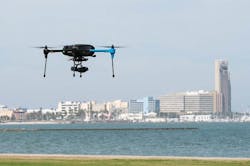As more drones take to the skies, safety has become a primary concern. To ensure that unmanned aerial vehicles (UAVs) do not interfere with both manned and unmanned vehicles of other kinds, NASA’s Unmanned Aircraft Systems Traffic Management (UTM) project selected the Lone Star UAS Center of Excellence and Innovation (www.lsuasc.edu) at Texas A&M University-Corpus Christi as one of only two sites across the U.S. to test drone traffic management.
The Lone Star team plans to start testing this summer, focusing on drone communications, collision avoidance, safe landing, safety in urban environments, and services that support UAS operations. NASA’s UTM project works closely with the Federal Aviation Administration to conduct field demonstrations of small unmanned aircraft systems to fully and safely access low-altitude airspace in support of civil and business opportunities.
NASA chose the Lone Star UAS Center of Excellence and Innovation at Texas A&M University-Corpus Christi as one of only two sites across the U.S. to test drone traffic management.
“The Lone Star Team is proud to have been selected by NASA to work on such critical testing efforts,” said Mike Sanders, Acting Executive Director of the Lone Star UAS Center of Excellence & Innovation. “This series of tests is a critical step in enabling the safe integration of unmanned aircraft systems within an urban environment. We look forward to working with NASA’s Ames Research Center, the City of Corpus Christi and its first responders, the Corpus Christi International Airport, the Port of Corpus Christi, as well as the many partners across Texas and the United States.”
NASA has been involved in a series of drone technology testing, increasing the complexity of tests each year. “Our (program) represents the most complicated demonstration of advanced UAS operating in a demanding urban environment that will have been tested to date,” said Ronald Johnson, NASA UTM project manager. “For the commercial drone industry to really advance, they need to see the results of this testing to understand the opportunities and challenges posed by flying in an environment where communications, GPS navigation, micro weather, tall buildings, and community acceptance all present hurdles to everyday, safe operation.”
About the Author
Jack Browne
Technical Contributor
Jack Browne, Technical Contributor, has worked in technical publishing for over 30 years. He managed the content and production of three technical journals while at the American Institute of Physics, including Medical Physics and the Journal of Vacuum Science & Technology. He has been a Publisher and Editor for Penton Media, started the firm’s Wireless Symposium & Exhibition trade show in 1993, and currently serves as Technical Contributor for that company's Microwaves & RF magazine. Browne, who holds a BS in Mathematics from City College of New York and BA degrees in English and Philosophy from Fordham University, is a member of the IEEE.


